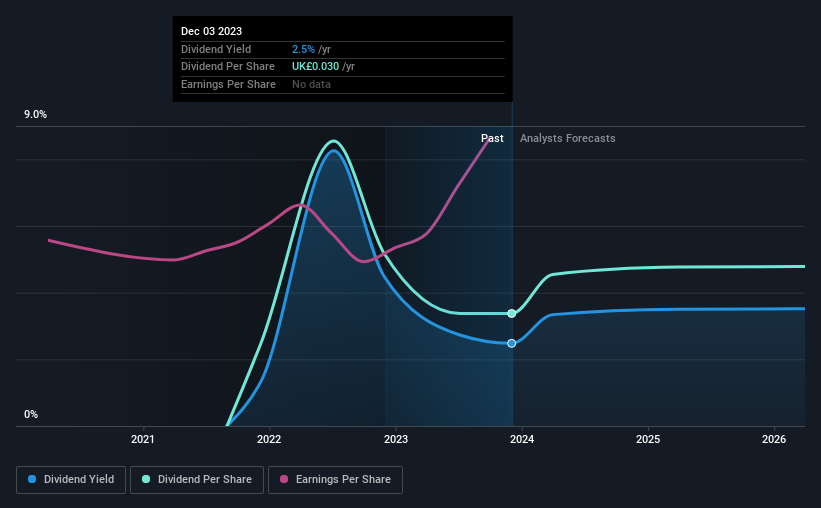Stock Analysis
- United Kingdom
- /
- Retail Distributors
- /
- AIM:SUP
Supreme (LON:SUP) Could Be A Buy For Its Upcoming Dividend

Supreme Plc (LON:SUP) is about to trade ex-dividend in the next 3 days. The ex-dividend date is one business day before a company's record date, which is the date on which the company determines which shareholders are entitled to receive a dividend. The ex-dividend date is of consequence because whenever a stock is bought or sold, the trade takes at least two business day to settle. Meaning, you will need to purchase Supreme's shares before the 7th of December to receive the dividend, which will be paid on the 12th of January.
The company's next dividend payment will be UK£0.015 per share, and in the last 12 months, the company paid a total of UK£0.03 per share. Looking at the last 12 months of distributions, Supreme has a trailing yield of approximately 2.5% on its current stock price of £1.21. Dividends are an important source of income to many shareholders, but the health of the business is crucial to maintaining those dividends. As a result, readers should always check whether Supreme has been able to grow its dividends, or if the dividend might be cut.
View our latest analysis for Supreme
Dividends are typically paid out of company income, so if a company pays out more than it earned, its dividend is usually at a higher risk of being cut. Supreme has a low and conservative payout ratio of just 24% of its income after tax. Yet cash flows are even more important than profits for assessing a dividend, so we need to see if the company generated enough cash to pay its distribution. It distributed 31% of its free cash flow as dividends, a comfortable payout level for most companies.
It's positive to see that Supreme's dividend is covered by both profits and cash flow, since this is generally a sign that the dividend is sustainable, and a lower payout ratio usually suggests a greater margin of safety before the dividend gets cut.
Click here to see the company's payout ratio, plus analyst estimates of its future dividends.

Have Earnings And Dividends Been Growing?
Companies with consistently growing earnings per share generally make the best dividend stocks, as they usually find it easier to grow dividends per share. Investors love dividends, so if earnings fall and the dividend is reduced, expect a stock to be sold off heavily at the same time. Fortunately for readers, Supreme's earnings per share have been growing at 16% a year for the past five years. Earnings per share are growing rapidly and the company is keeping more than half of its earnings within the business; an attractive combination which could suggest the company is focused on reinvesting to grow earnings further. This will make it easier to fund future growth efforts and we think this is an attractive combination - plus the dividend can always be increased later.
Many investors will assess a company's dividend performance by evaluating how much the dividend payments have changed over time. In the last two years, Supreme has lifted its dividend by approximately 17% a year on average. Both per-share earnings and dividends have both been growing rapidly in recent times, which is great to see.
To Sum It Up
From a dividend perspective, should investors buy or avoid Supreme? It's great that Supreme is growing earnings per share while simultaneously paying out a low percentage of both its earnings and cash flow. It's disappointing to see the dividend has been cut at least once in the past, but as things stand now, the low payout ratio suggests a conservative approach to dividends, which we like. Supreme looks solid on this analysis overall, and we'd definitely consider investigating it more closely.
While it's tempting to invest in Supreme for the dividends alone, you should always be mindful of the risks involved. In terms of investment risks, we've identified 2 warning signs with Supreme and understanding them should be part of your investment process.
A common investing mistake is buying the first interesting stock you see. Here you can find a full list of high-yield dividend stocks.
Valuation is complex, but we're helping make it simple.
Find out whether Supreme is potentially over or undervalued by checking out our comprehensive analysis, which includes fair value estimates, risks and warnings, dividends, insider transactions and financial health.
View the Free AnalysisHave feedback on this article? Concerned about the content? Get in touch with us directly. Alternatively, email editorial-team (at) simplywallst.com.
This article by Simply Wall St is general in nature. We provide commentary based on historical data and analyst forecasts only using an unbiased methodology and our articles are not intended to be financial advice. It does not constitute a recommendation to buy or sell any stock, and does not take account of your objectives, or your financial situation. We aim to bring you long-term focused analysis driven by fundamental data. Note that our analysis may not factor in the latest price-sensitive company announcements or qualitative material. Simply Wall St has no position in any stocks mentioned.
About AIM:SUP
Supreme
Supplies and distributes a range of consumer goods in the United Kingdom, Ireland, the Netherlands, France, rest of Europe, and internationally.
Outstanding track record with flawless balance sheet.

